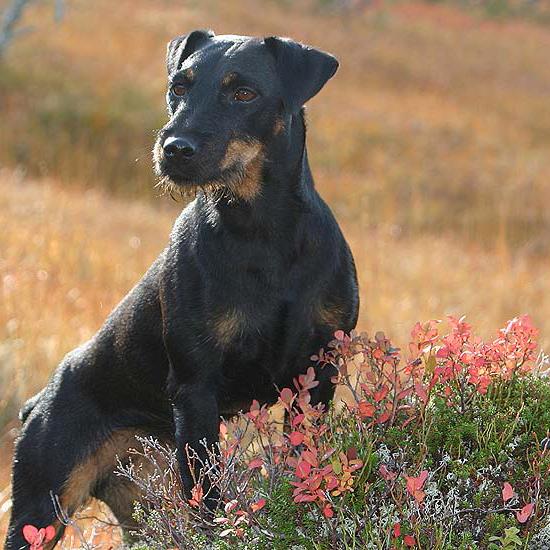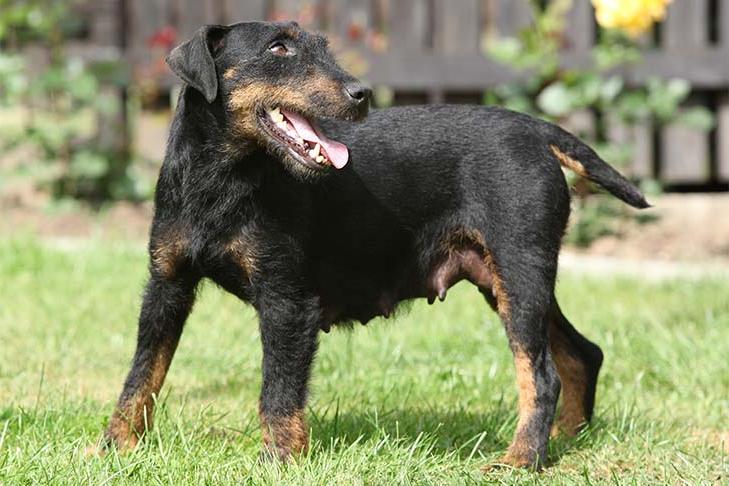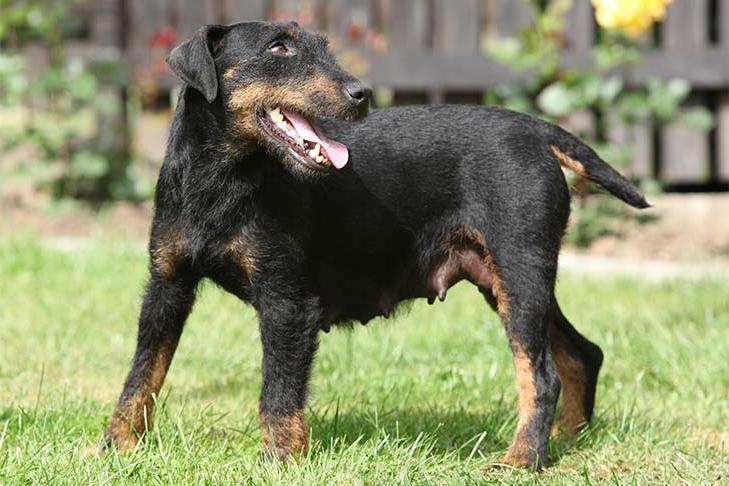- Breed Category: Terrier
- Country of Origin: Germany
- Average Height: 33-40 cm (13-16 in)
- Average Weight: Males 9-10 kg (20-22 lbs), Females 7.5-8.5 kg (16.5-18.7 lbs)
- Average Life Span: 10-12 years
- Grooming Requirements: Low, occasional brushing
- Exercise Requirements: High, needs daily exercise
- Coat Type: Dense, rough or smooth
- Coat Color Variations: Black, dark brown, grey
- Shedding Level: Moderate
- Ear Type: V-shaped, semi-erect
- Tail Type: Straight, often docked
- Temperament: Energetic, courageous, intelligent
- Intelligence Level: High
- Barking Tendency: Moderate to high
- Compatibility with Children: Good with proper socialisation
- Compatibility with Other Pets: May chase smaller animals
- Training Ease: Requires firm, consistent training
- Common Health Issues: Hip dysplasia, eye problems
- Dietary Needs: High-quality, protein-rich diet
- Energy Level: Very high
- Drooling Tendency: Low
- Sensitivity to Weather: Tolerates cold better than heat
- Overall Maintenance Level: Moderate
- Original Purpose: Hunting, vermin control
- Year of Recognition by Kennel Clubs: 1956
- Apartment Friendly: Not ideal, needs space
- Best Suited For: Active families, hunters
- Cost of Ownership: Moderate
- Unique Traits: Strong prey drive, versatile hunter
The Jagdterrier, a breed known for its tenacity and intelligence, is a small but mighty dog originally bred in Germany for hunting. With a sleek black and tan coat, this terrier is not just a pretty face; it’s a hardworking and versatile companion.
“The Jagdterrier is a true hunter at heart, with a drive and determination that’s hard to match,” says renowned dog trainer, Alex Thompson.
This article aims to delve into the unique characteristics, rich history, and essential care tips for the Jagdterrier. Whether you’re considering adding one to your family or simply curious about this fascinating breed, you’ll find valuable insights here.
History and Origin of the Jagdterrier

Early Development of the Breed
The Jagdterrier’s story begins in the early 20th century in Germany. Breeders aimed to create a dog that excelled in hunting, particularly for small game. They focused on developing a breed with a strong prey drive, intelligence, and resilience. The result was a compact, agile terrier with a keen sense of smell and an unwavering determination.
Role in Hunting and Working Environments
Jagdterriers quickly became favourites among hunters due to their versatility. They were bred to work both above and below ground, making them ideal for tracking and flushing out game. Their fearless nature and stamina allowed them to tackle challenging terrains and conditions, proving invaluable in the field.
Key Historical Figures
One of the pivotal figures in the creation of the Jagdterrier was Lutz Heck, a German zoologist. He, along with other enthusiasts, played a significant role in refining the breed’s characteristics, ensuring it met the rigorous demands of hunting. Their dedication laid the foundation for the Jagdterrier’s reputation as a reliable working dog.
Physical Characteristics of the Jagdterrier

Appearance
The Jagdterrier is a compact and muscular dog, typically weighing between 7 to 10 kilograms and standing about 33 to 40 centimetres tall. Its coat is predominantly black with distinctive tan markings on the face, chest, and legs, giving it a striking appearance. The coat itself is dense and harsh, providing protection against harsh weather and rough terrain.
Unique Physical Traits
One of the standout features of the Jagdterrier is its agile and robust build. This breed is designed for endurance and speed, making it an exceptional hunter. Its strong, straight legs and well-developed chest allow it to navigate through dense underbrush and challenging landscapes with ease. The Jagdterrier’s keen eyes and alert ears are always on the lookout, ready to spring into action at a moment’s notice.
Temperament and Behaviour of the Jagdterrier

Typical Personality Traits
The Jagdterrier is known for its loyalty and intelligence, making it a devoted companion. This breed is full of energy and thrives on activity, always ready for the next adventure. Its sharp mind and eagerness to learn make training a rewarding experience, though it requires consistency and patience.
Suitability as a Family Pet and Working Dog
As a family pet, the Jagdterrier can be a wonderful addition, especially for active households. Its playful nature and affectionate disposition endear it to family members, while its protective instincts offer a sense of security. In a working environment, the Jagdterrier excels, thanks to its strong work ethic and versatility. Whether it’s hunting or agility sports, this breed is up for the challenge.
Interaction with Children and Other Animals
Jagdterriers generally get along well with children, enjoying playtime and forming strong bonds. However, early socialisation is key to ensuring they interact positively with other animals. Their hunting instincts can sometimes lead to a strong prey drive, so supervision is recommended when introducing them to smaller pets.
Training and Exercise Needs of the Jagdterrier

Importance of Early Training and Socialisation
Getting a Jagdterrier off to a good start with early training and socialisation is crucial. These dogs are smart and eager to learn, but they need guidance to channel their energy positively. Introducing them to different environments, people, and other animals early on helps them grow into well-rounded adults. This foundation is key to preventing behavioural issues down the line.
Recommended Training Techniques
When it comes to training, consistency and positive reinforcement work wonders with Jagdterriers. They respond well to rewards and praise, making training sessions enjoyable for both dog and owner. Short, engaging sessions keep their attention and prevent boredom. Remember, patience is essential, as these terriers can be a bit stubborn at times.
Daily Exercise Requirements and Activities They Enjoy
Jagdterriers are bundles of energy, so daily exercise is a must. They thrive on activities that challenge both their bodies and minds. Long walks, play sessions, and agility training are great ways to keep them happy and healthy. These dogs love a good adventure, so mix up their routine with new experiences to keep them engaged.
Health and Lifespan of the Jagdterrier
Common Health Issues
Jagdterriers are generally robust, but like any breed, they can be prone to certain health issues. Common concerns include hip dysplasia, eye problems, and allergies. Regular vet check-ups are essential to catch any potential issues early. Keeping an eye on their weight and ensuring a balanced diet can also help prevent joint problems.
Average Lifespan and Health Tips
With proper care, Jagdterriers typically live between 12 to 15 years. To keep them healthy, regular exercise is crucial. These dogs have high energy levels and need plenty of physical and mental stimulation. A mix of walks, playtime, and training sessions will keep them in top shape. A nutritious diet tailored to their needs is also vital for their overall well-being.
Preventative Care Recommendations
- Schedule regular vet visits for vaccinations and health screenings.
- Maintain a consistent exercise routine to prevent obesity and related health issues.
- Brush their teeth regularly to prevent dental problems.
- Check their ears and eyes for any signs of infection or irritation.
- Provide a balanced diet with high-quality dog food.
Grooming and Maintenance of the Jagdterrier

Coat Care and Grooming Routines
The Jagdterrier’s coat is dense and harsh, designed to protect against the elements. Regular grooming is essential to keep it in top condition. A weekly brush will help remove dirt and loose hair, keeping the coat looking sleek and healthy. Use a firm bristle brush to tackle any tangles and maintain the coat’s natural shine.
Shedding and Seasonal Grooming Tips
Jagdterriers are moderate shedders, with shedding increasing during seasonal changes. During these times, more frequent brushing can help manage the extra hair. A good bath every few months, or as needed, will keep them fresh, but avoid over-bathing as it can strip the coat of its natural oils. Pay attention to their nails, ears, and teeth as part of the grooming routine to ensure overall health and hygiene.
Diet and Nutrition for the Jagdterrier

Nutritional Needs for Optimal Health
Jagdterriers are active dogs with specific nutritional needs to support their energy levels and overall health. A balanced diet rich in protein is essential to maintain their muscle mass and fuel their adventures. Look for high-quality dog food that lists meat as the first ingredient, ensuring they get the necessary amino acids.
Foods to Include and Avoid
Include lean meats, fish, and vegetables in their diet to provide a variety of nutrients. Omega-3 fatty acids from fish oil can support their coat and joint health. Avoid foods high in fillers, artificial additives, and excessive grains, as these can lead to allergies and digestive issues. Always steer clear of chocolate, onions, and grapes, which are toxic to dogs.
Feeding Schedules and Portion Recommendations
Establish a consistent feeding schedule, typically twice a day, to help regulate their metabolism and prevent overeating. Portion sizes should be based on their weight, age, and activity level. Consult your vet for specific recommendations, but generally, an adult Jagdterrier will need about 1 to 1.5 cups of food per day, divided into two meals. Adjust portions as needed to maintain a healthy weight.
Fun Facts and Trivia about the Jagdterrier
Interesting Tidbits about the Breed
The Jagdterrier, often referred to as the “German Hunt Terrier,” is renowned for its exceptional hunting skills. Despite its small size, this breed is known for its courage and determination, often taking on game much larger than itself. Interestingly, the Jagdterrier’s name is derived from the German word “Jagd,” meaning “hunt,” which perfectly encapsulates its primary purpose.
These dogs are not just hunters; they are also excellent swimmers. Their webbed feet make them adept in water, allowing them to retrieve game from lakes and rivers with ease. This versatility makes them a favourite among hunters who require a dog that can perform in various environments.
Famous Jagdterriers in Media or History
While the Jagdterrier may not be as famous in mainstream media as some other breeds, it has made its mark in the hunting community. One notable Jagdterrier, named “Max,” was celebrated for his exceptional tracking abilities, often featured in hunting magazines for his prowess. Max’s legacy continues to inspire hunters and Jagdterrier enthusiasts worldwide.
Final Thoughts

The Jagdterrier is a dynamic blend of intelligence and tenacity. This breed’s rich history and versatile nature make it a remarkable companion for active families and hunters alike. While their high energy and strong prey drive present challenges, the rewards of owning a Jagdterrier are immense, from their loyalty to their impressive hunting skills. Embrace the journey of training and bonding with this spirited breed, and you’ll find a devoted partner ready for any adventure. Consider welcoming a Jagdterrier into your life and experience the joy of a truly exceptional canine companion.
